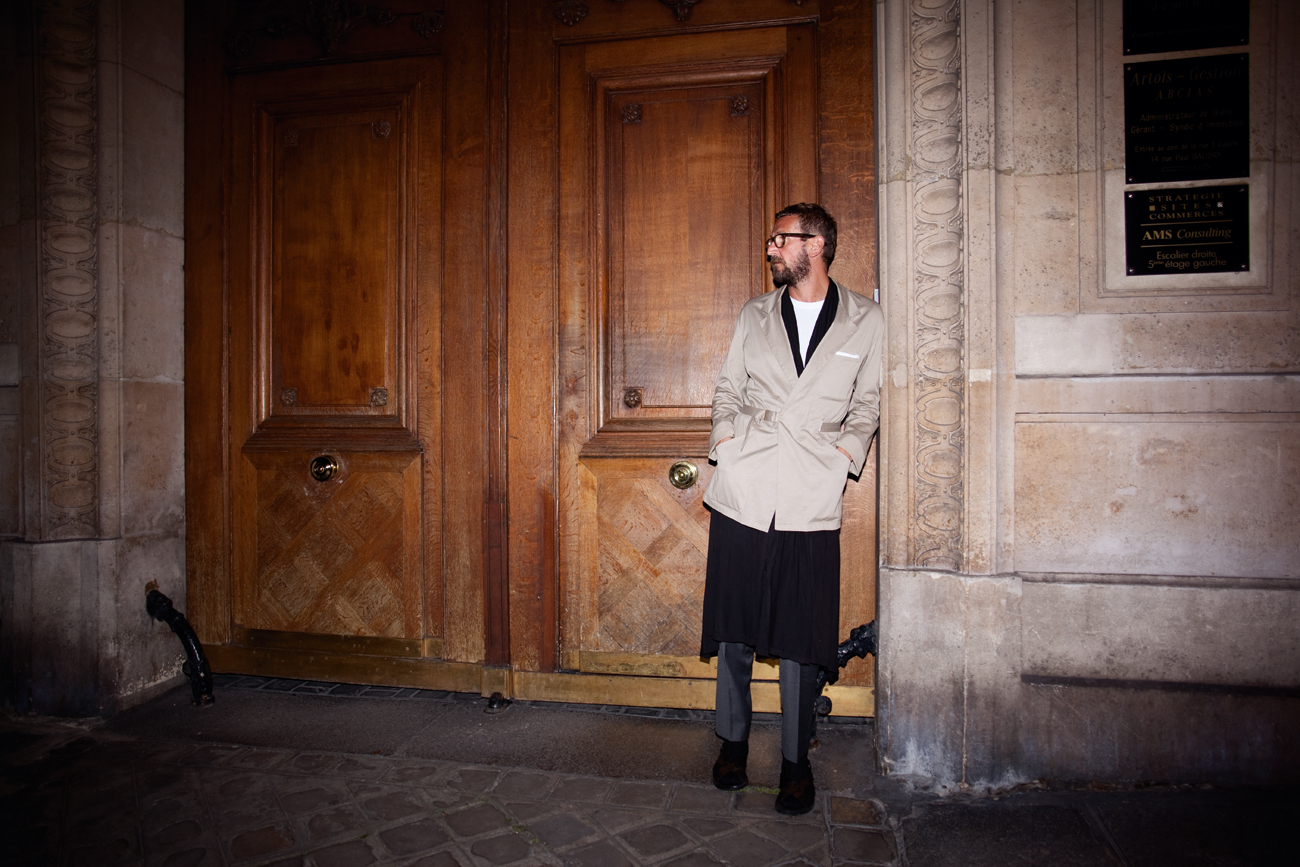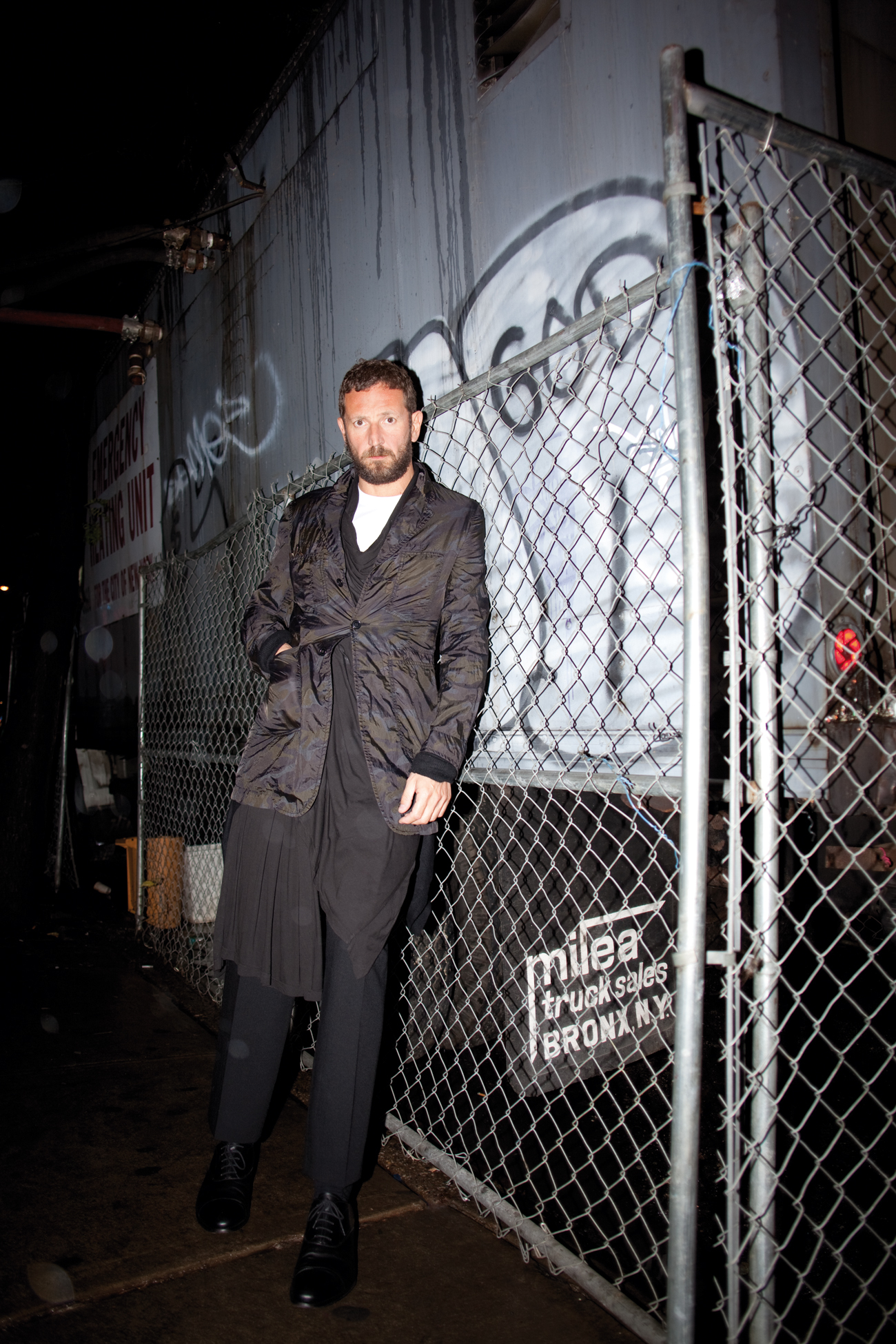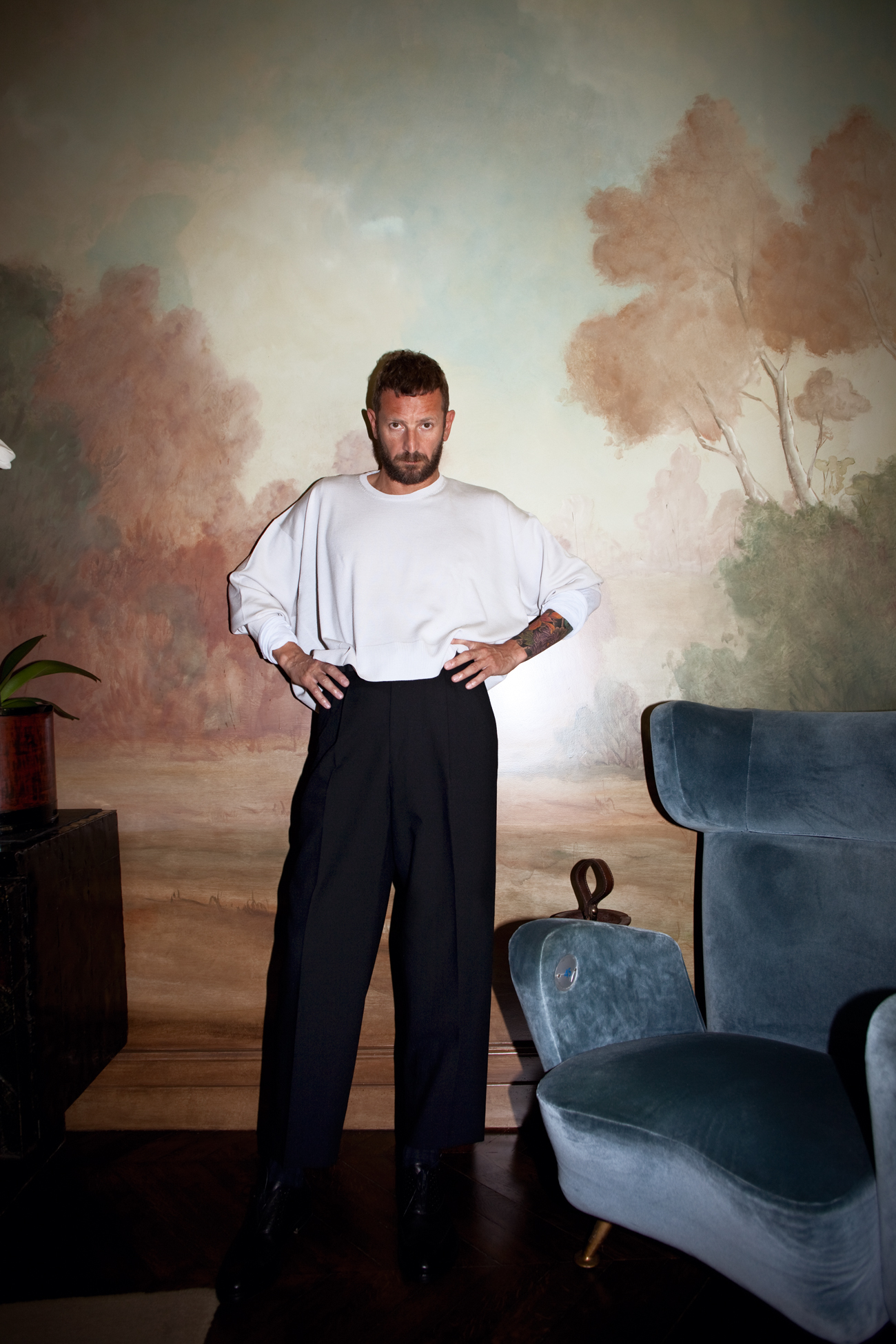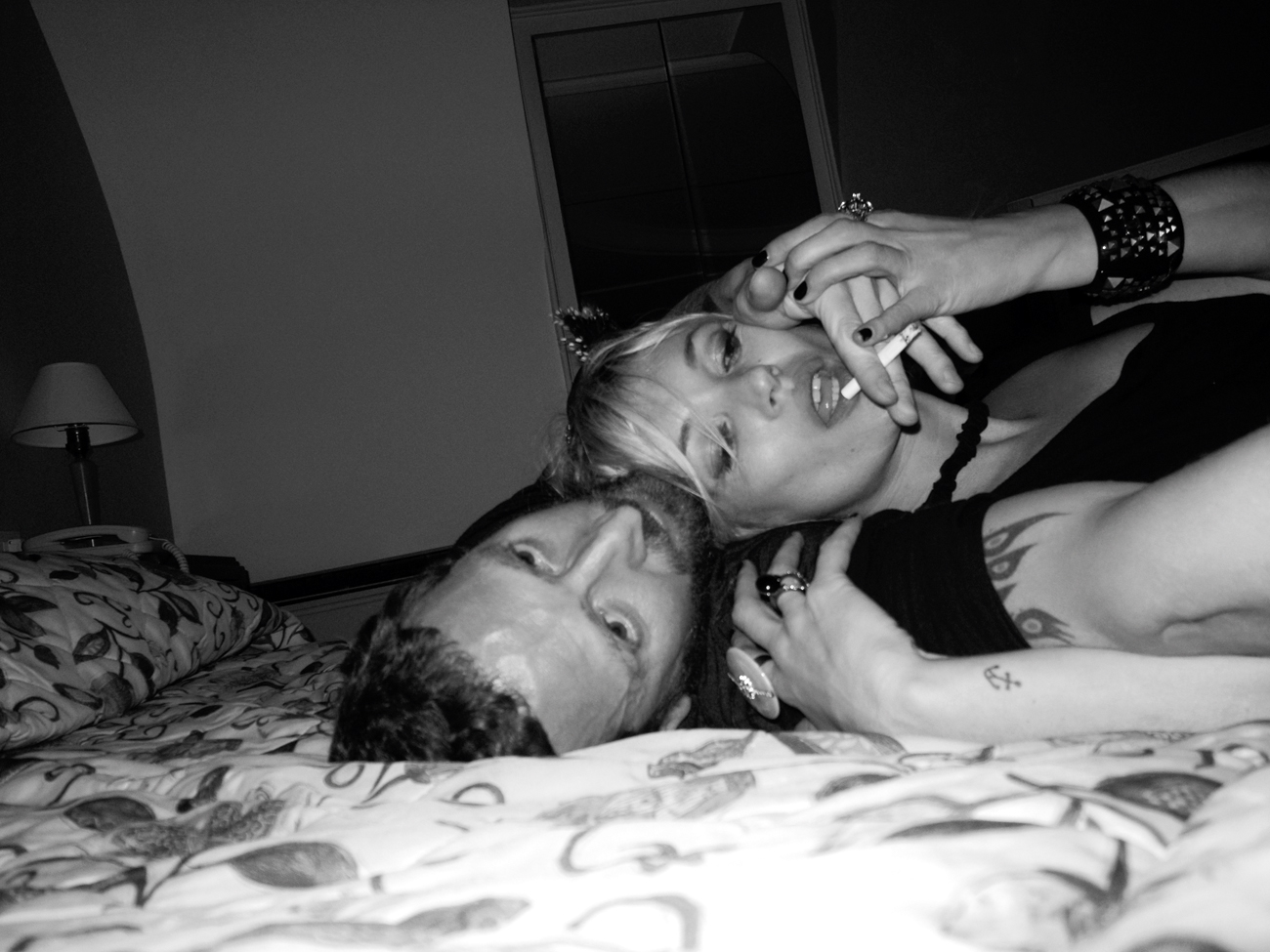Purple Magazine
— F/W 2009 issue 12
Stefano Pilati
 Satin jacket and cotton cashmere voile pants YVES SAINT LAURENT, long black sleeveless cardigan JULIUS, white crewneck t-shirt HANES, and brown leather sandals YVES SAINT LAURENT
Satin jacket and cotton cashmere voile pants YVES SAINT LAURENT, long black sleeveless cardigan JULIUS, white crewneck t-shirt HANES, and brown leather sandals YVES SAINT LAURENT
 Cropped gray sweater, kid mohair high-waisted pants, and black leather lace-up brogues YVES SAINT LAURENT
Cropped gray sweater, kid mohair high-waisted pants, and black leather lace-up brogues YVES SAINT LAURENT
 Vintage black and green camouflage print jacket COMME DES GARÇONS HOMME PLUS, long black shawl JULIUS, kid mohair high-waisted pants YVES SAINT LAURENT, white crewneck t-shirt hanes, and vintage leather oxford shoes PRADA
Vintage black and green camouflage print jacket COMME DES GARÇONS HOMME PLUS, long black shawl JULIUS, kid mohair high-waisted pants YVES SAINT LAURENT, white crewneck t-shirt hanes, and vintage leather oxford shoes PRADA
 Crepe de chine cuffed jacket YVES SAINT LAURENT, long sleeve t-shirt RICK OWENS, and white pleated work pants DICKIES
Crepe de chine cuffed jacket YVES SAINT LAURENT, long sleeve t-shirt RICK OWENS, and white pleated work pants DICKIES
 Merino knit poncho RICK OWENS, black cotton pants YOHJI YAMAMOTO and leather oxford shoes PRADA
Merino knit poncho RICK OWENS, black cotton pants YOHJI YAMAMOTO and leather oxford shoes PRADA
 Cropped gray sweater, kid mohair high-waisted pants, and black leather lace-up brogues YVES SAINT LAURENT
Cropped gray sweater, kid mohair high-waisted pants, and black leather lace-up brogues YVES SAINT LAURENT
 Vintage boxy lambswool jacket YVES SAINT LAURENT and bespoke herringbone striped shirt TURNBULL AND ASSER
Vintage boxy lambswool jacket YVES SAINT LAURENT and bespoke herringbone striped shirt TURNBULL AND ASSER
photographs and interview by OLIVIER ZAHM
Yves Saint Laurent designer Stefano Pilati is one of the best-dressed men in Paris. His unconventional elegance is a mix of feminine and masculine, simple and sophisticated, and casual and formal. Stefano is one of the men I most like to photograph at night. So I thought the best way to capture his unique vision of men’s fashion would be to present pictures I took of him over the course of several weeks, at shows, at dinner, and at parties — a portrait of a stylish man on the town.
OLIVIER ZAHM — When you design for men at YSL, do you use yourself as a reference and imagine yourself wearing the clothes, or do you keep a distance between what you wear and what you design for other men?
STEFANO PILATI – No, my designs are only for me! [Laughs] I’m the origin of the idea, but not exactly the main inspiration for it. One of my collections, for example, was inspired by the writer Paul Bowles. Anything can be a source of inspiration, but it has to be translated to the reality of the clothes. I translate it using myself as the judge. I’m not the kind of person who tries to create a uniform for himself. I change my look all the time. It depends on my mood, and it does spill into my collections. I consider myself to be quite average. I’m just an ordinary person with a deep interest in fashion and style, and when I design for men, I hope it’ll be something men will appreciate.
OLIVIER ZAHM — You’re not into personal uniforms? Don’t most men like them? Once I find something I like I wear it all the time, just so I can forget about having to find the right look every morning.
STEFANO PILATI -Most men are like that, but not me. My vanity is greater than average. [Laughs] It’s simply a true love for clothes. Even when I was a kid — and later on when I just started working in fashion — I was picking out fabrics and imagining what to wear. I started in men’s collections. I would find some beautiful silk or linen and I would imagine a jacket, one like I’d want to wear. And I would design one for myself.
OLIVIER ZAHM — Can you wear everything that you design for men?
STEFANO PILATI – Yes, everything. If there are pieces that I design that I wouldn’t wear, that has more to do with my age. I may try something on and think it’s exactly the way I like it, but I can’t see myself wearing it because I’m already too old.
OLIVIER ZAHM — I think you do the best leather jacket on the market — for me, that is. But I never see you wearing a leather jacket.
STEFANO PILATI – That’s an example of something that doesn’t feel quite right on me. It’s just not me. Maybe because of my beard, or maybe it’s because I’d look like somebody who hangs out in the Marais all the time. I like those guys, but they’re not me. And again, a leather jacket is such a uniform — it identifies you. I’m more subtle and complex than that.
OLIVIER ZAHM — It’s quite difficult to define your style. It’s always elegant and unique. And – it’s not a trick — it’s not like you go ’30s dandy just to break away from the street.
STEFANO PILATI – I think my personal style is purely a reflection of my personality, which is quite dark, but also positive and open. It’s rather masculine, but also feminine. It’s seductive, but without showing off. I don’t necessarily think it’s sexy, or at least being sexy isn’t what I have in mind when I dress up. I dress up for the pleasure of dressing up. If it turns out that it’s sexy, I like it! I consider that to be a part of the rules of seduction you adhere to when you dress yourself. Sure, you dress for yourself, but you also dress for others. You do want others to look at you — or to notice you, more than look at you. I do stand out, and I don’t know why. Sometimes I’ll dress really, really simply. Like today: white t-shirt and black pants. —
OLIVIER ZAHM — As you said, it’s a combination of two aspects. It’s dark and strong and manly, but not aggressive. It’s soft and subtle, and there’s always something delicate about it. Maybe it’s your Mediterranean touch?
STEFANO PILATI – I don’t know — I don’t think that my design should necessarily be considered Italian.
OLIVIER ZAHM — Well, it’s certainly not, say, Belgian or Japanese.
STEFANO PILATI – No. But I don’t know if it’s Italian, either, to tell you the truth.
OLIVIER ZAHM — I really like the way you approach men’s fashion, because it’s so relaxed. You don’t try too hard. You don’t take it too seriously, or act like it’s a big deal. I think it’s good for men to maintain a certain distance from clothes. Even though they’re important, they won’t transform your personality.
STEFANO PILATI — It’s odd — in fact, it’s almost the opposite of the way unisex or androgyny was considered in the ’70s, when it was more about women’s clothes being worn by men. In my case, it’s almost the opposite. I know many women who say to me, “I want to dress up like you!” But, I’m a man — and I’m like, “But look at everything else I do for you! Why don’t you just put on this dress and forget about my pants!” [Laughs] But they actually do want to wear my pants, probably because they find that delicacy you’ve just described, that easiness. It’s stylish, but effortlessly so.
OLIVIER ZAHM — You know a lot about recent men’s fashion. You like to wear Yohji Yamamoto or Rick Owens for example. At the same time you’re not stuck in the Yves Saint Laurent heritage of men’s fashion.
STEFANO PILATI – Well, the YSL men’s heritage doesn’t really exist! A certain community of French men probably know YSL, but his men’s collections were actually never exported as widely as his women’s collections were — neither the prêt-a-porter nor the couture. It was never really that successful. In fact, there’s almost nothing in the YSL archive.
OLIVIER ZAHM — For me, it was his boutique on Place Saint Sulpice that defined his Saint Germain-des-Prés esthetic: a certain jacket, the big belts, the suit — but it was more connected to the way we imagined Yves Saint Laurent himself to be.
STEFANO PILATI — Exactly. He was extremely fashionable in the ’70s but he went very classic later. There’s really not a lot I can pick up from his heritage.
OLIVIER ZAHM — What do you think of men’s fashion today?
STEFANO PILATI — Men’s fashion has changed a lot. It’s a disaster really, the men you see walking down the street. There’s no proportion, no sense of style. People look for comfort more than anything else. That’s the reason for the success of those shoes that are a bit city and a bit sporty. [Laughs] Why not have a nice pair of brogues, a nice pair of clogs for the weekend, and a pair of sneakers to go walking in? But it’s all mixed up now.
OLIVIER ZAHM — So, you’re not inspired by the street, which I can understand. Where do you find your inspiration? Do you search your memories of when you were younger, in the ’70s and early ’80s?
STEFANO PILATI – Yes, for sure, but only because it was all so new. Certain silhouettes that I use now — very tapered three-pleat pants, broad-shouldered short jackets, and stuff like that — were new in the ’80s, in the sense that they’d never been seen before.
OLIVIER ZAHM — Did you start to be interested in your look at an early age?
STEFANO PILATI – I started deciding what to wear when I was eight or nine and I started to hang around fashion people when I was sixteen. I felt different very early. I realized that when I tried to belong to a certain group based mostly on musical affinities, and wear things everyone else was wearing, I still wore them differently. I was a punk, mod, New Romantic, whatever, but always with a twist. Most of the time I was rejected. Even when I wanted to be a New Romantic, I was only pretending. I was wearing my sister’s clothes — short ’80s dresses with a sash. [Laughs] I was wearing a blouse over pants, maybe with a blazer on top. Then, when the ’80s really started and everybody was doing volume and layers, I decided to go ’70s. When I was 18 years old I was wearing flat pants and bell-bottoms, a big necklace, big hair, Rasta hats, and round John Lennon glasses. It was a mind-fuck. I’ve never really been able to fit into a category. Maybe I was creating a lot of my own problems — because I was always an outcast — but what was considered a weakness became my strength. I was so into fashion. Anything that was going to be the latest thing I either got or I already had. I was a bit ahead of the time with my style, and that isolates you. You go to school and everybody points at you. That really happened to me. People looked at me and left me in the cold, like I was a monster. But six months later everybody was wearing the thing I had been wearing.
OLIVIER ZAHM — You could see the effect your look had on the other kids?
STEFANO PILATI – Absolutely. I’m not bragging here — I was always pushed away.
OLIVIER ZAHM — When you saw friends following your style, did you realize you could become a designer?
STEFANO PILATI – At first people asked me to be a stylist for magazines. And when I started working as a stylist, I realized quickly I could be a designer. I was dressing all these models for fashion shoots, thinking, “I could do better than this.” So I decided to learn what it meant to be a designer. I didn’t become a designer by chance. I really learned how to become one.
OLIVIER ZAHM — You do realize that Maison Martin Margiela doesn’t have a designer, and that Helmut Lang is making art. There’s a long list of designers who used to be very important in menswear in the ’90s who aren’t working in fashion anymore. There’s a lot of expectation for your work, and for YSL menswear. You’re one of the best designers for men out there now, Stefano.
STEFANO PILATI – I don’t know. I’m not aware of it. I told you earlier that I never really feel like I’m part of a group.
OLIVIER ZAHM — I like that you take it in such a relaxed way, that you don’t try too hard. But I think that what you do at YSL for men is really important for us. You’re in a position to really bring a modern look to men who want creative clothes, without looking overdressed or trendy. You’re very classic in your approach. You don’t follow trends. It’s more about style.
STEFANO PILATI – I think that’s the way YSL for men should be. Maybe a few years ago I wouldn’t have said this — but I really consider myself to be very elegant and stylish. I wish that everybody could be the same way.




















































































































